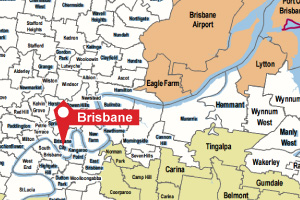
When hire car assistant Nicole, who lives in the US, heard that Australia has a chance to eradicate fire ants before they get out of control she had just one message for us.

I couldn’t have found a better way to be among the world’s leading experts on red fire ants than by dashing off to the US at the last minute to attend the annual fire ant conference in Albuquerque, New Mexico.
Taking part in this conference has been the fastest way of gathering stories about what it’s like to live with fire ants, a fearsome menace currently contained to an area roughly the size of the ACT in south east Queensland.
The people I spoke to at the conference were battle-weary. They have spent decades studying fire ants, being bitten by them, sharing ways of controlling them.
When I told them my mission is to bring back stories about what it’s like living with out-of-control fire ants so that I can warn Australians and our politicians about what’s in store for us if we fail to eradicate them now there was a universal look of disbelief. Why would anybody want them?
Ring of fire
Red fire ants live in nests that rise up out of the ground in a cone that marks the entrance to a deep catacomb where they live and breed. If their nest is disturbed they quickly rise up, aggressively swarming their intruder.
They then signal to each other using pheromones and, in unison, stab their abdomen stinger into the intruder’s flesh. Hundreds of ants strike at once.
People here say the stings feel like being on fire, and if attacked often resort to desperate measures to rid themselves of the pain. It’s not uncommon for victims to strip down to their underwear, or even to shed their clothes completely in an attempt to shake themselves of the ants.
Even as I drove through Alabama there was tragic news of a fire ant death in a town I passed. Just days before, Kalyn Rolan was simply sitting on a haystack when the fire ants attacked. The mother of two went into anaphylactic shock, causing her body to swell to the point where she could not breathe. Emergency services arrived too late to save her.
Eighty people in the US have died from fire ant attacks after suffering an anaphylactic reaction, and so schools with even mild ant infestations heavily treat their grounds with a bait the fire ants take back to their nests, where it is ingested and eventually kills off the colony.
Want to hold your wedding outdoors? The grounds need to be treated months in advance.
Like to make a bit of a fashion statement with thongs or sandals when outside? Forget about it, they’re an open invitation to a fire ant attack.
There are now areas in the US that have been infested by fire ants for so long now that younger people have no memory of living without them.
For the rest of my trip I plan to travel across fire ant infected zones collecting more stories about what it’s like living with these menacing creatures.
Now, more than ever, I am determined to return to Australia with these stories. Because, unlike the US, we still have time to fully eradicate fire ants before they get out of control, but only if our politicians are prepared to act now.
Donate to support our work so we can eradicate red fire ants from Australia.
Take action
Experts say it would cost $40-$50 million a year spent over the next decade to eradicate fire ants from South East Queensland. The alternative is unthinkable. If fire ants get out of control Queensland alone faces a 30-year damage bill of $43 billion, dwarfing the cost of eradication.
In 2016, federal, state and territory governments will be making decisions behind closed doors about whether to properly fund the fire ant eradication program, with a final decision to be made in November. If the eradication program remains poorly funded, as it has been for the past 15 years, millions of Australians will have to suffer the pain of living with fire ants.
Our nation will be transformed forever.
Please join us in calling on federal and state governments around Australia to properly fund the red fire ant eradication program by signing our Change.org petition today >>
And don’t forget to donate to support our work to rid Australia of this deadly ant.


